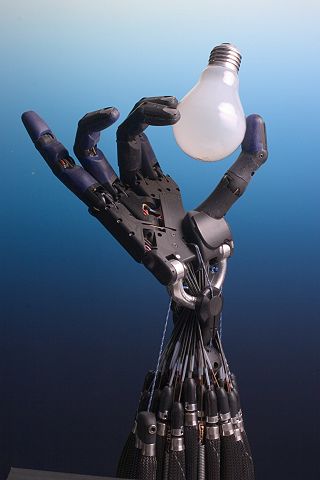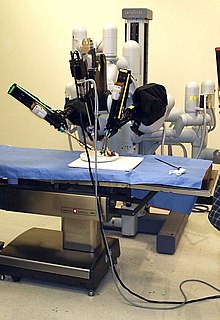
A robot is a machine—especially one programmable by a computer—capable of carrying out a complex series of actions automatically. A robot can be guided by an external control device, or the control may be embedded within. Robots may be constructed to evoke human form, but most robots are task-performing machines, designed with an emphasis on stark functionality, rather than expressive aesthetics.

In medicine, a prosthesis, or a prosthetic implant, is an artificial device that replaces a missing body part, which may be lost through physical trauma, disease, or a condition present at birth. Prostheses are intended to restore the normal functions of the missing body part. Amputee rehabilitation is primarily coordinated by a physiatrist as part of an inter-disciplinary team consisting of physiatrists, prosthetists, nurses, physical therapists, and occupational therapists. Prostheses can be created by hand or with computer-aided design (CAD), a software interface that helps creators design and analyze the creation with computer-generated 2-D and 3-D graphics as well as analysis and optimization tools.

An industrial robot is a robot system used for manufacturing. Industrial robots are automated, programmable and capable of movement on three or more axes.
Biorobotics is an interdisciplinary science that combines the fields of biomedical engineering, cybernetics, and robotics to develop new technologies that integrate biology with mechanical systems to develop more efficient communication, alter genetic information, and create machines that imitate biological systems.
BrainGate is a brain implant system, currently under development and in clinical trials, designed to help those who have lost control of their limbs, or other bodily functions, such as patients with amyotrophic lateral sclerosis (ALS) or spinal cord injury. The Braingate technology and related Cyberkinetic’s assets are now owned by privately held Braingate, Co. The sensor, which is implanted into the brain, monitors brain activity in the patient and converts the intention of the user into computer commands.
Domo is an experimental robot made by the Massachusetts Institute of Technology designed to interact with humans. The brainchild of Jeff Weber and Aaron Edsinger, cofounders of Meka Robotics, its name comes from the Japanese phrase for "thank you very much", domo arigato, as well as the Styx song, "Mr. Roboto". The Domo project was originally funded by NASA, and has now been joined by Toyota in funding robot's development.

Joseph Frederick Engelberger was an American physicist, engineer and entrepreneur. Licensing the original patent awarded to inventor George Devol, Engelberger developed the first industrial robot in the United States, the Unimate, in the 1950s. Later, he worked as entrepreneur and vocal advocate of robotic technology beyond the manufacturing plant in a variety of fields, including service industries, health care, and space exploration.

Unimation was the world's first robotics company. It was founded in 1962 by Joseph F. Engelberger and George Devol and was located in Danbury, Connecticut. Devol had already applied for a patent an industrial robotic arm in 1954; U.S. patent 2,988,237 was issued in 1961.
Bio-mechatronics is an applied interdisciplinary science that aims to integrate biology and mechatronics. It also encompasses the fields of robotics and neuroscience. Biomechatronic devices cover a wide range of applications, from developing prosthetic limbs to engineering solutions concerning respiration, vision, and the cardiovascular system.
Coco is the latest platform at the Massachusetts Institute of Technology's Humanoid Robotics Group, and a successor to Cog. Unlike previous platforms, Coco is built along more ape-like lines, rather than human. Coco is also notable for being mobile. Although there is ongoing research on the robot, the group has many robots dealing with human interactions. The Humanoid Robotics Group has planned to add more useful functions in the future, but have not set an exact date for such project.

A robotic arm is a type of mechanical arm, usually programmable, with similar functions to a human arm; the arm may be the sum total of the mechanism or may be part of a more complex robot. The links of such a manipulator are connected by joints allowing either rotational motion or translational (linear) displacement. The links of the manipulator can be considered to form a kinematic chain. The terminus of the kinematic chain of the manipulator is called the end effector and it is analogous to the human hand. However, the term "robotic hand" as a synonym of the robotic arm is often proscribed.

The history of robots has its origins in the ancient world. During the industrial revolution, humans developed the structural engineering capability to control electricity so that machines could be powered with small motors. In the early 20th century, the notion of a humanoid machine was developed.

Robotics is the branch of technology that deals with the design, construction, operation, structural disposition, manufacture and application of robots. Robotics is related to the sciences of electronics, engineering, mechanics, and software.

Robotics is the interdisciplinary study and practice of the design, construction, operation, and use of robots.
The following outline is provided as an overview of and topical guide to robotics:

Justin is an autonomous and programmable humanoid robot with two arms, developed by the German Aerospace Center (DLR) at the Institute of Robotics and Mechatronics, located in Wessling, Germany. Introduced in 2009, this wireless robot is controllable through telepresence, a type of technology that allows a person to feel as if they were present from a location other than their true location.

The space-opera blockbuster, Star Wars franchise has borrowed many real-life scientific and technological concepts in its settings. In turn, Star Wars has depicted, inspired, and influenced several futuristic technologies, some of which are in existence and others under development. In the introduction of the Return of the Jedi novelization, George Lucas wrote: "Star Wars is also very much concerned with the tension between humanity and technology, an issue which, for me, dates back even to my first films. In Jedi, the theme remains the same, as the simplest of natural forces brought down the seemingly invincible weapons of the evil Empire."

A robot leg is a mechanical leg that performs the same functions that a human leg can. The robotic leg is typically programmed to execute similar functions as a human leg. A robotic leg is similar to a prosthetic leg. However, a robotic leg can be controlled electrically or mechanically. To have the robotic leg emulate human leg behaviors, surgeons must redirect the nerves that previously controlled some of the person’s lower-leg muscles to cause the thigh muscles to contract. Sensors embedded in the robotic leg measure the electrical pulses created by both a re-innervated muscle contraction, and the existing thigh muscle.

Zephyr is a concept of a robotic Venus rover for a mission called Venus Landsailing Rover. This mission concept would place a rover on the surface of Venus that would be propelled by the force of the wind. The rover would be launched together with a Venus orbiter that would perform both communications relay and remote atmospheric studies.


















